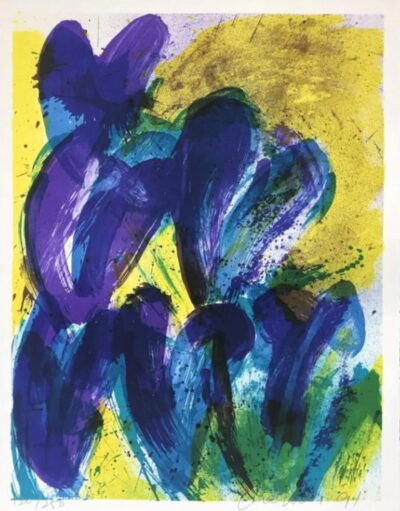Jan Cremer
 Jan Cremer (1940) is mostly known as a writer and adventurer but actually spends much more time working as a painter and sculptor. He was educated at the academy of Arnhem where he became friends with Klaas Gubbels and Mark Brusse. Together they created the collective Nada which got them the attention of the art world in Amsterdam.
Jan Cremer (1940) is mostly known as a writer and adventurer but actually spends much more time working as a painter and sculptor. He was educated at the academy of Arnhem where he became friends with Klaas Gubbels and Mark Brusse. Together they created the collective Nada which got them the attention of the art world in Amsterdam.
In 1957 Cremer painted the first of a number of paintings that would be known under the name of ‘Peinture Barbarisme’ (Scheen 1969-1970).In 1958 (at the tender age of eighteen), he had his first solo exhibition at the gallery De Posthoorn in The Hague. His participation in the Salon of The Hague(1958) immediately resulted in scandal. Already one year later he was invited to exhibit at the Haags Gemeentemuseum and in 1960 in the Stedelijk Museum, Amsterdam, two of the main institutions for modern art in the Netherlands. In 1964 his famous book ‘Ik Jan Cremer’ (or: ‘I Jan Cremer’ saw the light of day and it would go on to sell millions of copies internationally.
Subsequently Jan departed for New York where he worked for a while as the editor in chief of pop magazine Hullaballoo and photographer for girl’s magazine Nugget. In addition he also wrote a number of plays.
From the sixties onwards he travels extensively for about six months a year to America, Siberia, Mongolia, Greenland, Africa and Europe.
During these travels he develops his new passion for documentary film making. In 1972 his film ‘The long white trail’, about his adventures with the Inuit sees the light of day.
As a painter Jan Cremer is well known for his Dutch themed paintings with tulips and cows. He started this genre from his time in the US onwards.
Cremer’s work can be found in the collections of Gemeentemuseum Den Haag, Stedelijk Museum Amsterdam, Gemeentemuseum, Arnhem and Museum Fodor, Amsterdam.
Jan Cremer has won many international and prestigious awards, including the Jacob Maris Award in 1960.
